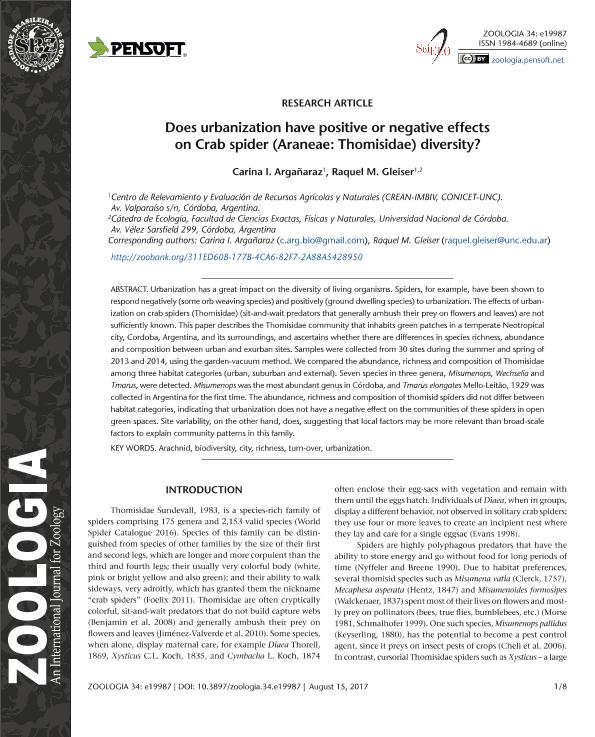Artículo
Does urbanization have positive or negative effects on Crab spider (Araneae: Thomisidae) diversity?
Fecha de publicación:
01/2017
Editorial:
Sociedade Brasileira de Zoologia
Revista:
Zoologia (Curitiba)
ISSN:
1984-4670
e-ISSN:
1984-4689
Idioma:
Inglés
Tipo de recurso:
Artículo publicado
Clasificación temática:
Resumen
Urbanization has a great impact on the diversity of living organisms. Spiders, for example, have been shown to respond negatively (some orb weaving species) and positively (ground dwelling species) to urbanization. The effects of urbanization on crab spiders (Thomisidae) (sit-and-wait predators that generally ambush their prey on flowers and leaves) are not sufficiently known. This paper describes the Thomisidae community that inhabits green patches in a temperate Neotropical city, Cordoba, Argentina, and its surroundings, and ascertains whether there are differences in species richness, abundance and composition between urban and exurban sites. Samples were collected from 30 sites during the summer and spring of 2013 and 2014, using the garden-vacuum method. We compared the abundance, richness and composition of Thomisidae among three habitat categories (urban, suburban and external). Seven species in three genera, Misumenops, Wechselia and Tmarus, were detected. Misumenops was the most abundant genus in Córdoba, and Tmarus elongates Mello-Leitão, 1929 was collected in Argentina for the first time. The abundance, richness and composition of thomisid spiders did not differ between habitat categories, indicating that urbanization does not have a negative effect on the communities of these spiders in open green spaces. Site variability, on the other hand, does, suggesting that local factors may be more relevant than broad-scale factors to explain community patterns in this family.
Palabras clave:
Arachnid
,
Biodiversity
,
City
,
Richness
,
Turn-Over
,
Urbanization
Archivos asociados
Licencia
Identificadores
Colecciones
Articulos(CCT - CORDOBA)
Articulos de CTRO.CIENTIFICO TECNOL.CONICET - CORDOBA
Articulos de CTRO.CIENTIFICO TECNOL.CONICET - CORDOBA
Citación
Argañaraz, Carina Inés; Gleiser, Raquel Miranda; Does urbanization have positive or negative effects on Crab spider (Araneae: Thomisidae) diversity?; Sociedade Brasileira de Zoologia; Zoologia (Curitiba); 34; 1-2017
Compartir
Altmétricas




